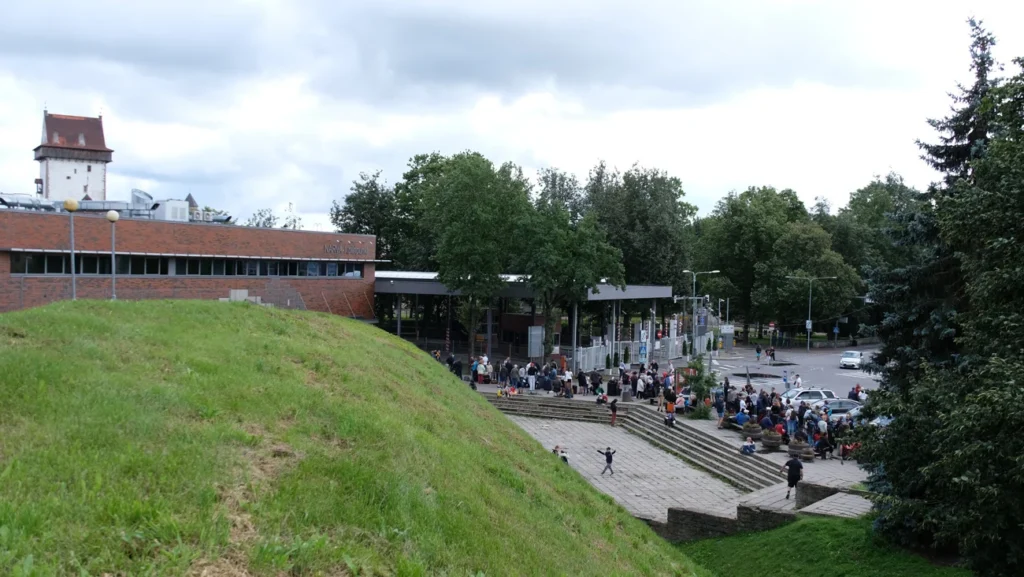Narva receives a trading press and the right to have his scales and declares his desire to become a member of the Hansa

Arnold Paul Suvalep. « History of Narva. Danish and Livonian periods. » Start Here.
In July 1424, the city of Wiesbu told Tallinn that the pirates in the Gulf of Finland were again robbed by Russian merchants, and some of them were killed. As it turned out later, the attack on Russian ships occurred at sea 8 miles from Tallinn, where they were heading. The merchants were captured, and their goods were taken to land and divided there.
This time trade was not interrupted immediately because during this period there were many Russian merchants in the cities of Livonia. The Russians tried to demand, through the ambassadors, compensation for damage caused, but to no avail.
Already in September, the situation became so critical that Hansa banned the export of salt from Livonia. Novgorod in response to this forbade German merchants to leave his city. The cities of Livonia, in turn, responded with a ban on trade trips to the Neva and Novgorod. The Hanseatic cities tried to completely isolate Novgorod, asking Vyborg to join the blockade.
Border trade with Russians continued continuously. The departure of the goods, apparently, was Danzig, whose ships went to the Neva and Vyborg despite the fact that he informed his accession to a trade ban. For his part, the Narva Vogt also pretended that he was not known about the ban: the decree on the ban on salt was exported was once really made, but more than four years have passed since then, so let Tallinn be exported earlier. Even Tallinn tried to look at the trade ban through his fingers. The Tallinn Magistrate explained to the Narvsky VOGTU that he informed himself of the ban on trade with the Russians and this thing does not concern him more. Everyone is free to trade at their own peril and risk.
NO Hanseatic cities did not want to look at the problem from this point of view. They emphasized that the trade ban was declared at the request of the cities of Livonia themselves, and therefore we must ensure that trade with Russians in the Neva and in other places is stopped. Under the pressure of foreign cities and Tallinn, he was forced to look for some measures to restrict trade. At a congress of cities in Pyarn in June 1425, the ambassadors of Tallinn were instructed to talk with the rest of Livonia, whether they would agree that Tallinn would introduce a complete ban on the export of goods to Narva and whether Tartu is obliged to undertake trade with Narva, as well as with Pskov.
The solid support of the master of the Livonian order so much inspired Narva that she began to make her demands to Tallinn already in an ultimative form. Through Lubeck, Narva passed these wishes to the congress of Hanseatic cities. She stated that she was ready to join in the future to all trading blockades of Hansa.
Merchants detained in Novgorod were kept in very difficult conditions. Only thanks to the intervention of the bishop, not everyone was imprisoned. The Germans who appeared on the streets were shackled in a chain. The conditions of detention were so difficult that out of 150 detained Germans, 36 died. The Russian bailiffs scored one German to death, they kept the other for 9 weeks in the house of the executioner and tortured so that he died.
On August 24, 1425, the master of the Order of Tsissa von Rutenberg visited Narva. He granted the city the right to weigh the goods transported through Narva, so that at the funds received from weighing, to strengthen the city walls. As indicated in privileges, the city received these rights for nothing as a gift from a master. In addition, the master granted the city the right to perform the court on half of the Narva River. This privilege had a double meaning for the city: it significantly increased the revenues of the city and made it possible to control the fact that the Tallinn merchants did not trade with the Russians on the river without the permission of the Narva magistrate.
Negotiations with Novgorod, which were held in the fall of 1425, had no results. Hanseatic cities with concern watched how merchants began to move to Stockholm, Turku, Vyborg and other cities of Sweden and Finland. Salt trade in Narva acquired an unusually wide scope. The master of the Order refused to join the trade ban even when bishops and King of Denmark (respectively and Sweden) would join him. Tallinn was forced to look for power measures of pressure. The Narva merchant Godek Westfal, for example, was confiscated from 1,500 skins. The Narva Vogt strongly defended Westfal, since the latter did not enter the Hansa, but only belonged to the Narva merchants.
In November, events changed dramatically. Novgorod at the insistence of his bishop released German merchants to freedom and allowed trade with the Germans. Lubeck, for his part, also decided to temporarily allow trade with the Russians until the congress of the cities of Hansa would make a certain decision on this score.
Thus, now trade, it would seem, could resume. But the master of the Order of Tsissa von Rutenberg intervened and ordered that Russian merchants from Russia do not have the right to go further than before Narva. At a request from Tallinn, the master replied that the Russians had previously caused considerable damage to the Narva merchants, and now their travel to Tallinn would not be allowed until this damage will be accepted. Thus, Tallinn turned out to be cut off from Russian trade and could only sell goods through Narva. The situation was complicated by the fact that in the spring the peace treaty of the Danish king with Novgorod ended, and Vyborg Fogt in order to avoid possible misunderstandings, warned against visiting the mouth of the Neva. The Narva Vogt at that time was an outstanding man, the future master of the Livonian Order of Henry Shungel. He maintained a close connection with Finland and, on his assignment, in 1426, his servant Eilhard Licht, the future secretary of the Narva magistrate, visited there.
On January 17, 1426, Master Tsissa von Rutenberg issued Narve to stamp wax and other goods transported through Narva. The order was depicted on the press. The wax was the most important product brought from Russian lands in exchange for salt. The wax of Rus’ was checked for quality, weighed and stamped. For this, the city took a special tax. The city seal was a guarantee of wax quality for other cities. Until now, the branding of goods on the southern coast of the Gulf of Finland was the exclusive right of Tallinn.
The solid support of the master of the Livonian order so much inspired Narva that she began to make her demands to Tallinn already in an ultimative form. Through Lubeck, Narva passed these wishes to the congress of Hanseatic cities. She stated that she was ready to join in the future to all the trading blockades of Hansa and will come to terms even with the fact that her merchants will be covered with access to the Novgorod trading courtyard, but provided that her merchants will be granted the right to buy weight salt in the Tallinn harbor right from ships and deliver their goods to the Novgorod market through trade intermediaries, in other words, speaking of trade alliance Hanseatic merchants. In the case of a trade blockade, the city should have the right to carry out border trade in food products. In addition, the city should have granted the right to believe the court over the violators of the trade ban caught in Narva, as well as the right to confiscate the detained goods in favor of the city. Finally, the Hanseatic cities must recognize the trading print issued by the Master of the Order of the city so that the goods, stamped in Narva, in the cities of the Hansa would not need to be checked, weighed and taxed.
As we see, the wishes of the Narva were carefully thought out. They were so large -scale that at the congress of the cities of Hansa, which took place on July 24, 1426 in Lubeck, they were regarded as the intention of Narva to join the Hanseatic Union. These desires in Lubeck were still not satisfied, but it was decided to refer this issue to the cities of Livonia. In relation to Narva, at every opportunity, they continued to resort to pressure tactics.
In 1426, there was a large exchange of land in Alutaguz. Already in the XIII century, the Cystean monastery of Karkn belonged in Alutaguz large lands in the territory of the current church parishes of Lyuganuze, Yykhvi and Yizaku. Back in 1411, the Order agreed on the exchange of these territories and gave the monastery in return for the land of the parish of the course. 21 Villages in Alutaguz were transferred to the order: Virunurm, to tear, Voroper, Moldova, Karilype, Kurtnet, Ediver, Syirumae, Jizaku, Kuru, etc. All these villages were put at the disposal of the Narva Vogt.
(To be continued)
The Post Narva receives a trading press and the right to have his scales and declares his desire to become a member of the Hansa FIRST Appeared on gazeta.ee.








